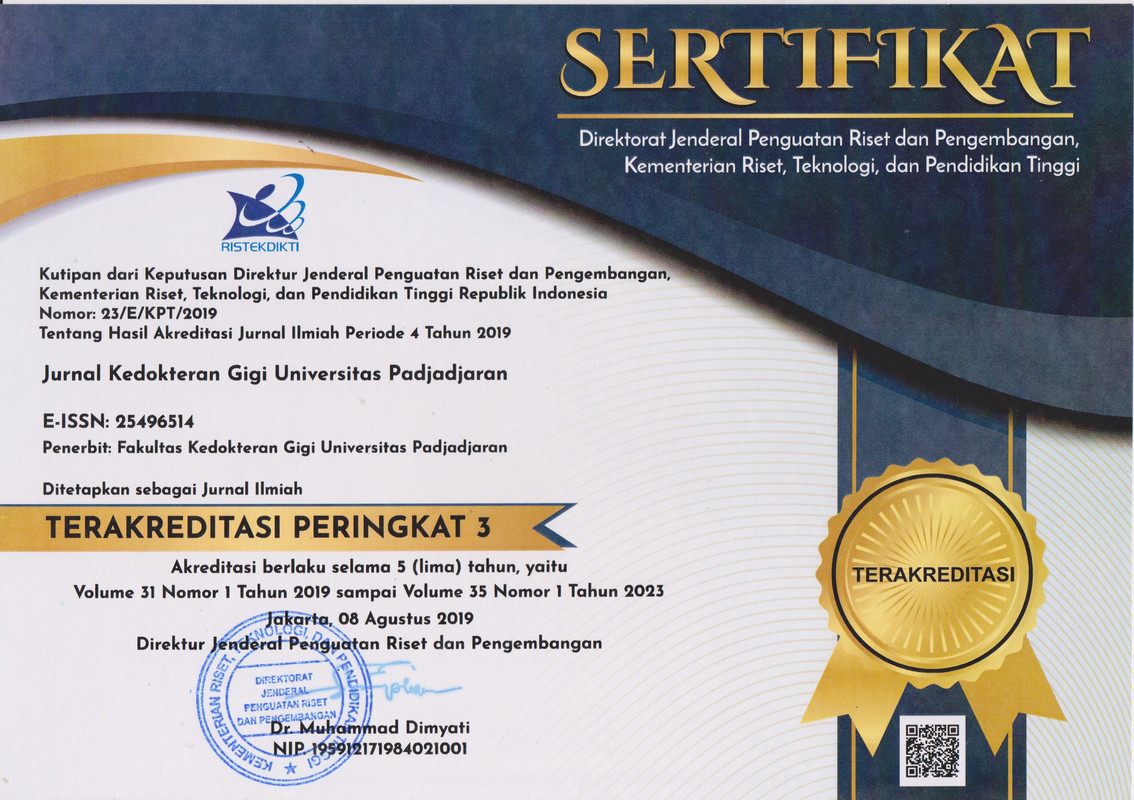Antimicrobial efficacy of calcium hydroxide nanoparticle and nisin against Enterococcus faecalis in root canal therapy: an experimental study
Abstract
Efektivitas antimikroba nanopartikel kalsium hidroksida dan nisin terhadap Enterococcus faecalis pada perawatan saluran akar: studi eksperimen
Pendahuluan: Kegagalan perawatan saluran akar umumnya disebabkan oleh pembersihan bakteri patogen yang tidak efektif di saluran akar yang terinfeksi. Bakteri E. faecalis adalah bakteri persisten yang menjadi etiologi pada kasus ini. Bakteri E. faecalis memiliki mekanisme pompa proton yang mampu melawan aksi ion OH-, sehingga menghambat efektivitas Ca(OH)2. Antimikroba lain, yaitu Nisin merupakan peptida yang mampu menembus membran plasma bakteri dan menyebabkan lisis sel. Tujuan penelitian ini adalah mengevaluasi efektivitas nanopartikel Ca(OH)2 dan kombinasinya dengan nisin terhadap E. faecalis. Metode: Pada tahap pertama, penelitian terdiri dari 8 kelompok nisin dengan konsentrasi (10-200 mg/mL) dan 3 kelompok nanopartikel Ca(OH)2 konsentrasi (0,425-1,7 mg/mL). Semua kelompok diuji dengan metode difusi terhadap E. faecalis pada hari ke-1 dan ke-5. Bagian kedua, nanopartikel Ca(OH)2 dikombinasikan dengan konsentrasi nisin paling efektif dari penelitian tahap pertama (100 dan 150 mg/mL), kemudian diuji efektivitasnya pada hari ke-1, 3, 7, dan 14. Semua perlakuan diulang sebanyak tiga kali untuk memastikan standarisasi hasil. Analisis statistik dilakukan dengan uji ANOVA dan analisis post hoc (α=0,05). Hasil: Nisin dengan konsentrasi 100 mg/mL dan 150 mg/mL menunjukkan zona hambat terbesar, yaitu 14,33 dan 13,83 mm. Kombinasi nanopartikel Ca(OH)2 dan nisin menghasilkan zona hambat yang lebih kecil di pada pengukuran di hari ke-7 dan 14 dibandingkan dengan nanopartikel Ca(OH)2. Kesimpulan: Nanopartikel Ca(OH)2 dan nisin memiliki efek antimikroba terhadap E. faecalis. Nisin menunjukkan efek antimikroba yang lebih tinggi dibandingkan dengan nanopartikel Ca(OH)2, namun kombinasinya dengan nanopartikel Ca(OH)2 menghasilkan penurunan efektivitas antimikroba pada bakteri E. faecalis.
Keywords
Full Text:
PDFReferences
Barbosa-Ribeiro M, De-Jesus-Soares A, Zaia AA, Ferraz CCR, Almeida JFA, Gomes BPFA. Antimicrobial susceptibility and characterization of virulence genes of Enterococcus faecalis isolates from teeth with failure of the endodontic treatment. J Endod. 2016 Jul;42(7):1022-8. https://doi.org/10.1016/j.joen.2016.03.015
Dioguardi M, Di Gioia G, Illuzzi G, Arena C, Caponio VCA, Caloro GA, et al. Inspection of the microbiota in endodontic lesions. Dent J (Basel). 2019 May 1;7(2):47. https://doi.org/10.3390/dj7020047
Alghamdi F, Shakir M. The influence of Enterococcus faecalis as a dental root canal pathogen on endodontic treatment: a systematic review. Cureus. 2020 Mar 13; https://doi.org/10.7759/cureus.7257
Vasudeva A, Sinha DJ, Tyagi SP, Singh NN, Garg P, Upadhyay D. Disinfection of dentinal tubules with 2% chlorhexidine gel, calcium hydroxide and herbal intracanal medicaments against Enterococcus faecalis : an in-vitro study. Singapore Dent J. 2017 Dec;38:39-44. https://doi.org/10.1016/j.sdj.2017.06.001
Gopikrishna V. Grossman's Endodontic Practice. 14th ed. Chennai, India: Wolters Kluwer; 2020. p. 419.
Dianat O, Saedi S, Kazem M, Alam M. Antimicrobial activity of nanoparticle calcium hydroxide against Enterococcus faecalis: an in vitro study. Iran Endod J. 2014/12/24. 2015;10(1):39-43.
Sidiqa AN, Zakaria MN, Artilia I, Cahyanto A, Puti LN. Evaluasi kadar pH kalsium hidroksida hasil sintesis batu kapur alam sebagai alternatif bahan medikamen intrakanal. In: Preparing Dentist Approach Of The Industrial Revolution 40. Bali: Universitas Mahasaraswati; 2019. p. 24-9.
Sidiqa AN, Zakaria MN, Artilia I, Dewi ZY, Cahyanto A. Evaluation of calcium ion release in calcium hydroxide prototype as intracanal medicament. Journal of Dentomaxillofacial Science. 2020 Aug 1;5(2):86. https://doi.org/10.15562/jdmfs.v0i0.1017
Zakaria MN, Siti Halimah IR, Sidiqa AN, Artilia I, Cahyanto A. Antimicrobial activity of calcium hydroxide synthesized from Indonesian limestone against Enterococcus faecalis. Materials Science Forum. 2021 Aug 27;1044(August):171-7. https://doi.org/10.4028/www.scientific.net/MSF.1044.171
Zakaria MN, Sidiqa AN, Artilia I, Cahyanto A. Synthesis and characterization of calcium hydroxide from Indonesian limestone as endodontic intracanal medicament. Key Eng Mater. 2018 Oct;782:268-72. https://doi.org/10.4028/www.scientific.net/KEM.782.268
Sidiqa AN, Hanif F, Zakaria MN, Artilia I, Cahyanto A. Setting time of calcium hydroxide from Indonesian limestone paste with various solvent vehicle for intracanal medicament. Materials Science Forum. 2021 Aug 27;1044:165-70. https://doi.org/10.4028/www.scientific.net/MSF.1044.165
Sidiqa AN, Zakaria MN, Cahyanto A, Joni IM, Maskoen AM. Carbonation inhibitor by polyethylene glycol encapsulation of calcium hydroxide fine particles to improve antimicrobial and root canal penetration properties. Heliyon. 2023 Jul;9(7):e18005. https://doi.org/10.1016/j.heliyon.2023.e18005
Naseri M, Eftekhar L, Gholami F, Atai M, Dianat O. The effect of calcium hydroxide and nano-calcium hydroxide on microhardness and superficial chemical structure of root canal dentin: an ex vivo study. J Endod. 2019 Sep;45(9):1148-54. https://doi.org/10.1016/j.joen.2019.06.002
Lima SM de F, de Pádua GM, Sousa MG da C, Freire M de S, Franco OL, Rezende TMB. Antimicrobial peptide-based treatment for endodontic infections - Biotechnological innovation in endodontics. Biotechnol Adv. 2015 Jan 1;33(1):203-13. https://doi.org/10.1016/j.biotechadv.2014.10.013
Shin JM, Gwak JW, Kamarajan P, Fenno JC, Rickard AH, Kapila YL. Biomedical applications of nisin. J Appl Microbiol. 2016;120(6):1449-65. https://doi.org/10.1111/jam.13033
Mittal DP. In vitro evaluation of antibacterial efficacy of nisin calcium hydroxide and triple antibiotic paste in three different vehicle. Journal of Medical Science And clinical Research. 2019 May 26;7(5). https://doi.org/10.18535/jmscr/v7i5.140
Ehlinger C, Dartevelle P, Zaet A, Kurashige Y, Haïkel Y, Metz-Boutigue MH, et al. A new combination with D-Cateslytin to eradicate root canal pathogens. Int J Pept Res Ther. 2019 Dec 22;25(4):1679-87. https://doi.org/10.1007/s10989-019-09911-6
Kajwadkar R, Shin JM, Lin GH, Fenno JC, Rickard AH, Kapila YL. High-purity nisin alone or in combination with sodium hypochlorite is effective against planktonic and biofilm populations of Enterococcus faecalis. J Endod. 2017 Jun 1;43(6):989-94. https://doi.org/10.1016/j.joen.2017.01.034
Sidiqa AN, Fitriantama RW, Artilia I, Zakaria MN, Cahyanto A, Joni IM, et al. Effect of vehicles on the pH of nanoparticle calcium hydroxide from Indonesian limestone paste. Makassar Dental Journal. 2023;12(1):1-4.
Sidiqa AN, Afidi A, Suntana MS, Zakaria MN, Joni IM, Maskoen AM. Impact of Calcium Hydroxide Particle Size on the Intracanal Medicament Penetration Efficacy. Diffusion Foundations and Materials Applications. 2024 Dec 24;37:29-36. https://doi.org/10.4028/p-3F5ZnX
Artilia I, Sidiqa AN, Zakaria MN, Cahyanto A. Handling property improvement of nano calcium hydroxide from Indonesian limestone with different solvent vehicles. Journal of International Dental and Medical Research. 2021;14(2):1-5.
Ordinola-Zapata R, Noblett WC, Perez-Ron A, Ye Z, Vera J. Present status and future directions of intracanal medicaments. Vol. 55, International Endodontic Journal. John Wiley and Sons Inc; 2022. p. 613-36. https://doi.org/10.1111/iej.13731
Zhang C, Du J, Peng Z. Correlation between Enterococcus faecalis and Persistent Intraradicular Infection Compared with Primary Intraradicular Infection: A Systematic Review. J Endod. 2015 Aug 1;41(8):1207-13. https://doi.org/10.1016/j.joen.2015.04.008
Saghiri MA, Asatourian A, Orangi J, Lotfi M, Soukup JW, Garcia‐Godoy F, et al. Effect of particle size on calcium release and elevation of pH of endodontic cements. Dental Traumatology. 2015 Jun 8;31(3):196-201. https://doi.org/10.1111/edt.12160
Xu X, Xu L, Yuan G, Wang Y, Qu Y, Zhou M. Synergistic combination of two antimicrobial agents closing each other's mutant selection windows to prevent antimicrobial resistance. Sci Rep. 2018 Dec 1;8(1):7237. https://doi.org/10.1038/s41598-018-25714-z
Sidiqa AN, Zakaria MN, Artilia I, Dewi ZY, Cahyanto A. Evaluation of calcium ion release in calcium hydroxide prototype as intracanal medicament. Journal of Dentomaxillofacial Science. 2020;5(2):86. https://doi.org/10.15562/jdmfs.v0i0.1017
Harshitha V, Ranjini M, Nadig R. Antibacterial efficacy of nisin, calcium hydroxide, and triple antibiotic paste in combination with chitosan as an intracanal medicament against Enterococcus faecalis - An in vitro study. Journal of Conservative Dentistry. 2022;25(5):504. https://doi.org/10.4103/jcd.jcd_125_22
Mohamed AA, Fayyad DM, El-Telbany M, Mohamed DAA. Antibacterial biofilm efficacy of calcium hydroxide loaded on Gum Arabic nanocarrier: an in-vitro study. BMC Oral Health. 2024 Feb 10;24(1):215. https://doi.org/10.1186/s12903-024-03941-3
Haryanti TP, Nazar K, Margono A. Antibacterial efficacy of nisin as an irrigant againts enterococcus faecalis biofilm. International Journal of Applied Pharmaceutics. 2019 Apr 2;11(1):35-8. https://doi.org/10.22159/ijap.2019.v11s1.161
Duchateau ALL, van Scheppingen WB. Stability study of a nisin/natamycin blend by LC-MS. Food Chem. 2018;266(May):240-4. https://doi.org/10.1016/j.foodchem.2018.05.121
Pinheiro ET, Karygianni L, Attin T, Thurnheer T. Antibacterial Effect of High-Purity Nisin Alone and in Combination with D-Amino Acids or Chlorhexidine in an Endodontic-Like Biofilm Model. Antibiotics. 2021 Feb 2;10(2):149. https://doi.org/10.3390/antibiotics10020149
Lallukka M, Gamna F, Gobbo VA, Prato M, Najmi Z, Cochis A, et al. Surface functionalization of Ti6Al4V-ELI alloy with antimicrobial peptide nisin. Nanomaterials. 2022 Dec 6;12(23):4332. https://doi.org/10.3390/nano12234332
DOI: https://doi.org/10.24198/jkg.v37i2.63132
Refbacks
- There are currently no refbacks.
Copyright (c) 2025 Jurnal Kedokteran Gigi Universitas Padjadjaran
INDEXING & PARTNERSHIP

Jurnal Kedokteran Gigi Universitas Padjadjaran dilisensikan di bawah Creative Commons Attribution 4.0 International License






.png)

















